The extended winter conditions have not deterred our local owls from setting up territory and preparing for the nesting season.
Some of you may have heard the familiar call of the great horned owl, a distinctive deep booming Hoo! hu-hu-hu, Hoo! Hoo!
Great horned owls are one of the earliest breeding birds in North America; nesting season is in January or February, so their calls are more frequent at this time.
The great horned owl is the only large owl with prominent ear tufts. The larger size, bulky shape and white chest help to differentiate it from the similarly coloured long-eared owl.
In contrast with the adults, the juvenile great horned owl may not show ear tufts and call with a “screech” reminiscent of a barn owl.
Great horned owls do not build a nest of their own but utilize the nests of other birds such as the hawk, crow and heron.
They may also use squirrel nests, hollows in trees, rocky caves, clumps of witches broom, abandoned buildings, or artificial platforms.
The other owl species that you may have been lucky enough to hear in recent weeks is the western screech owl. Despite its name, it does not screech. This owl has two common calls: a hollow, whistled double trill, and a series of low whistles that speed up toward the end like a bouncing ball.
Hooting may occur in every month, but is most frequent from February through April when they are seeking a mate.
This small owl has conspicuous ear tufts and mottled brownish-grey plumage. Western screech owls nest in natural tree cavities, especially in large mature black cottonwood trees.
Loss and degradation of riparian habitat and removal of cottonwood trees have resulted in substantial declines in Western screech owl populations.
As a result, this owl is listed as a federally endangered species.
This owl is known to occur in riparian (creek side or lakeshore) habitats in Summerland. If you think you have heard or seen the Western screech owl, reports are appreciated.
For more information or to report a screech owl, contact Lisa Scott, coordinator of the Wildlife Tree Stewardship Program in the Okanagan-Similkameen at 250-404-0115 or witsos@shaw.ca or visit wildlifetree.ca.
